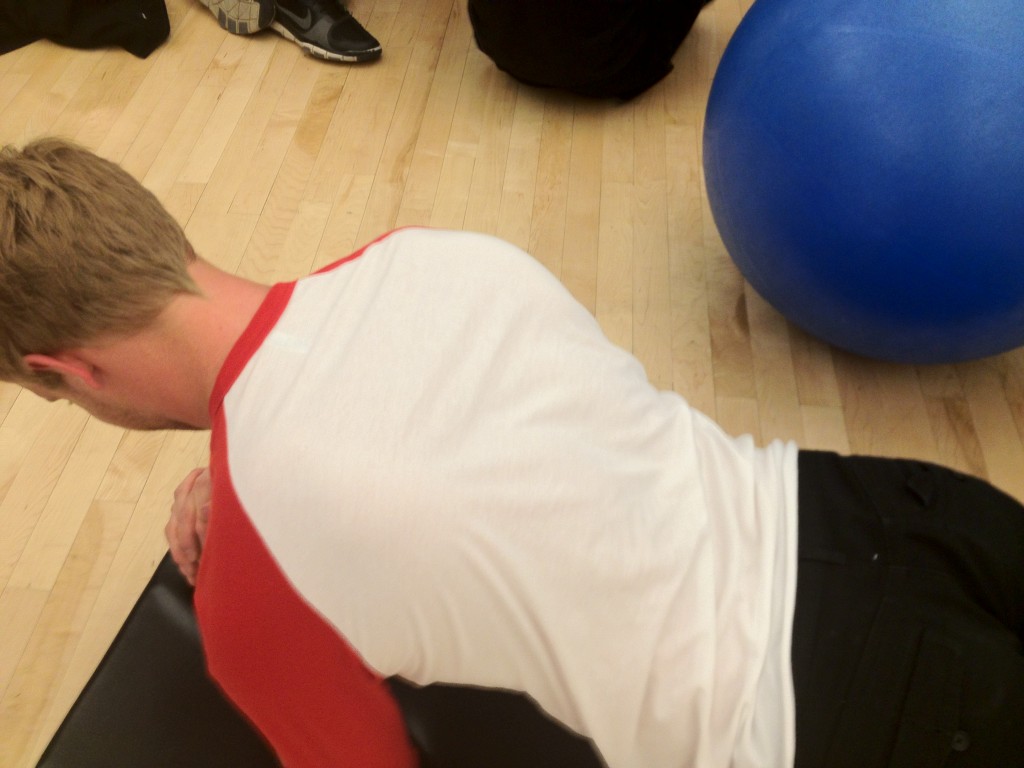Keeping shoulders healthy and moving without completely reeking of sucktitude is a big part of what I do on a daily basis. Most of my clients have pre-existing issues, but those who don’t are typically just waiting to have something go wrong as they’re the typical cubicle jockeys who hunch over their spreadsheets and want to be able to reach the top shelf of the cupboard without feeling like they just got RKO’d out of nowhere.
As a result, a lot of the shoulder exercises I wind up programming tend to be more restorative and focus on getting shoulder motion without losing joint control by gliding into anterior humeral glide or developing scapular dyskinesis. These are fancy words that pretty much mean I try to keep the golf ball on the tee as much as I possibly can.
This doesn’t mean they wind up being namby pamby exercises that work on mental toughness by trying to get the person to not bore themselves to death before completing their set. The main goals are always to encourage the muscles around the shoulder to control the movement of the humerus and maintain stability, get the shoulder blade moving well so that it doesn’t roll forward and shrug up into the persons neck, and also get the thoracic spine to move into extension and rotation as needed so the shoulder doesn’t have to do all of the work.
A key to a lot of these exercises is they’re actually quite position specific and require some degree of coaching, especially if the person doing them is rocking posture more resemblant of Mr. Burns or if their scapulae are so unstable and winging out like the doors on a DeLorean.
As a result, I’ll give some of the big coaching cues to work for on each of the exercises, but they’ll most likely need some coaching to get the best bang for their buck. That said, even getting them 70% right will help your shoulders feel juicy and mobile as all get out.
#5: Half Kneeling Elastic Rotation
This is an exercise that focuses on thoracic extension and rotation, but also requires the shoulders to move through rotation, get the scapula moving, and provides a veritable Rubik’s Cube of benefits. It’s an easy move to set up. Just get an elastic, hook it to something that won’t move, and then set up so that your hips are pointing at a 90 degree angle to the pull of the elastic. Place the leg closest to the elastic in the forward position forward and hold the elastic with the outside hand. Keep the elbow straight and rotate the arm up like you want to brush your bicep against your ear, ensuring you turn your hips to get the rotation from the body.
#4: Prone Elastic Shoulder Rotations
This is commonly known as shoulder dislocates, and commonly uses a stick, but I found it was really restricted with a stick whereas an elastic allows a lot more freedom of movement, plus some tension to expansion that makes the shoulders work a little to maintain control through the rotation versus just going limp and dealing with it.
Also, I like to get these done in prone versus standing because it makes the person use a little thoracic extension and doesn’t allow for forward head posture to creep in, which is a common issue with folks who have cranky shoulders. Essentially, I like idiot proof variations of stuff over things that require advanced calculus to figure out, so this one works really well.
#3: Band Pull Aparts
These can be tricky if the person has a tendency to let the shoulders roll forward or shrug with retraction, so think about keeping the chest up and head back with the shoulders low and keep the reps high as possible.
For people with slumping shoulders and a forward head posture, this exercise is gold. It works the muscles that retract the scapulae, and also encourages spinal extension with cervical retraction or the shoulders will wind up in your ears and rolling more than the Alabama Tide.
#2: Kettlebell Screwdrivers
This is one of those exercises that you look at and think “What the hell kind of kindergarten stuff is this? I’m going to dominate the hell out of that exercise and make everyone bow down to me and my greatnesswhen I rock this place.” Then you do it. And you suck at life.
This one requires more balance and coordination than grip strength, but the first thing everyone does with any bottoms up position is try to wipe the sweat off their hands when they fail epically. In truth, if you have the weight balanced, you can do the work without touching your thumb or little finger to the bell. Just make sure you don’t drop the bell on your face and wind up wearing it like a lip ring.
#1: Turkish Get Up
Another one of those “lots of stuff going on” exercises, the turkish get up makes the shoulder move through a big multiplanar range of motion, puts a principle on stability through the entire movement, and even involves some hip and core fun to boot. There’s a reason why the best in the world at doing this make it look effortless, and it’s because their relative exertion is kept really low. It’s like loaded yoga, and if you find yourself breathing in short hard gasps, you’re not controlling the movement well enough.
These are just five exercises I tend to program a fair bit of with a wide variety of clients. Sure they’re not going to be appropriate with some people, but those who can do them benefit from them a lot. Give them a try in your next workout and see what they do for you.
- See more at: http://deansomerset.com/favourite-5-shoulder-health-exercises/#sthash.rbPrrbXS.dpuf

Комментариев нет:
Отправить комментарий